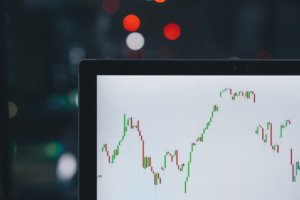Markets Outlook: Market data points to doom and gloom, but some bright patches emerge
AxiTrader’s Global Chief Market Strategist Stephen Innes looks in detail at the entire global market structure this week, and also details some of the commentary around the volatility of certain asset classes from expert points of view

By Stephen Innes, Chief Global Market Strategist, AxiTrader
US Week Ahead
This week’s data will start to echo at great length the economic devastation from the onset of COVID-19 and the associated containment measures.
Thursday’s jobless claims remain the most important metric to follow. Using the best real-time data available, analysts believe we’re on the verge of topping the four-week total of 25 million, which is over ten times the prior worst four-week period in the last 50-plus years. Accordingly, this unparalleled surge in claims should push the unemployment rate up to 17% in the April data, a new post-World War II high.
Looking on the bright side, and hopefully keeping investors on cloud nine as they digest a veritable smorgasbord of doom and gloom real-time data, monetary policymakers continue to deploy their broadened toolkit aggressively. Late last week, in their finest hour, the Federal Reserve Board detailed steps to provide $2.3tn to support the economy. They’re delivering on three critical fronts: corporate credit facilities to support lending for large businesses, the Main Street Business Lending Program (MSBLP) to boost liquidity for loans to small-and-medium-sized industries, and further support for the municipal bond market.
Indeed, the Fed is clearing a credit path using a real battering ram of cash with unmatched force.
These decisions were momentous given the unprecedented scope of lending and QE that’s currently underway, with the Fed venturing into sub-investment grade bonds (through “fallen angels” and HY ETFs), loans to smaller businesses, syndicated loans and, more broadly, into municipal debt.
Asia Week Ahead
I’m sticking with the doom and gloom prophecies.
This week, China’s GDP report will attract much attention as it should also provide an advantageous reference point for benchmarking the probable effects of COVID-19 on economic activity in other economies. The recent run of high-frequency data points to a very sharp downturn in China’s GDP growth where current estimates are coming in around -7.5%yoy in Q1 from +6% in Q4. High-frequency data will likely remain downcast for March, even though better than in February; despite economic activities partially resuming, the outlook for exports remains depressed as the critical markets are not consuming due to lockdown.
Trading Outlook Next Week
There are three fundamental benchmarks investors continue to focus on as they progress through the world of COVID19; flattening of the epidemic curve, the strength of the economic policy response and an exit strategy – including possibly a combination of better tracing, testing, treatment and eventually a cure.
- More signs that the virus incidence in Europe is abating is hugely positive for risk.
- Policymakers widely delivering a ‘whatever it takes’ (including the kitchen sink) policy is another massive positive for risk.
- As such, the focus has shifted very quickly to whether and how countries might emerge from lockdown, and whether there’ll be a need for repeated ‘circuit breakers.’
But deferring to a simple math theorem of 1+2-3 =0, it suggests to me the blue sky that the market has been tacking at might be a bit premature as we continue to sail upwind. Without a successful “unlockdown” strategy, who’s to say we won’t remain in some form of stringent mobility restriction until the virus completely dies off?
Oil Markets Week Ahead
A day late and a barrel short seems to be the initial verdict from last week’s OPEC and G20 energy meeting summit.
While supply dynamics will have much less influence over prices after the production cut, markets will still likely need to weather the constant demand-side storm until the production cuts come into effect in May.
Unfortunately for oil bulls, demand may plunge by as much as 27 million barrels per day (mb/d) in April, a decline more massive than anything else in the history of oil. How much of this is in the price is yet to be seen. Also complicating matters is how quickly the sudden stop in demand sieves back to the wellhead capping dynamics.
Last week a decrease in anticipated supply offset lower anticipated demand, resulting in higher oil prices. This week we should see a more heavily weighted shift to demand dynamics, suggesting that storm clouds for oil prices will continue to build on the horizon.
Even more worrisome for oil demand is that India, the world’s third-biggest consumer, has collapsed by as much as 70%, which is adding to the unprecedented oil demand devastation around the globe.
Oil Demand Slumps 70% in India Bloomberg.
The Gold Market Week Ahead
Even although risk sentiment is turning “green,” the real economy is still shaky enough to attracts safe-haven demand.
Gold prices are rising, fuelled by massive stimulus from the Fed and increases in joblessness which is the reason triggering the Fed to pre-paper over all the data cracks with money. What should translate into a positive view for gold this week is we will likely have a veritable smorgasbord of nasty real-time data do digest.
Forex
G-10 Trade of the Week
The Australian Dollar
I’m morphing from the reversion trade to a bullish flat out view on the Aussie.
The Australian dollar has several things in its favor at present, being far too weak versus its G-10 peers notwithstanding.
Statistically, the virus is much less of a problem in Australia as infections per capita are well below half of the US and most of Europe. And it’s not like Australia is merely playing catch-up – virus growth has already moderated plenty and is amongst the lowest in the world (2% in recent days). A result of excellent medical management and the combination of early containment and a quality health care system put Australia head and shoulders above many – not to mention the excellent fortune of being an island and able to control inbound people flows more effectively. One risk to watch: Australia soon approaches winter.
The iron ore price is resilient and there are tentative signs of a relatively quick return to activity in China, which could bode well for Australia. Last Tuesday, Bloomberg reported that Rio Tinto Group’s iron ore business is seeing pretty normal demand levels. Iron ore unit chief executive officer Chris Salisbury told 6PR radio that Rio Tinto is “pleased China has come back so fast.” – the mining giant sells more than 70% of its iron products to China. Meanwhile, there’s an evident recovery in copper prices, which supports AUD also.
Portfolio outflows may abate given Australia’s more restrained QE; the bond yield is relatively high in the wake of the collapse of North American returns. And since the struggling AUD has exaggerated the fall in local equities, we may even see the repatriation of foreign investment funds if the Australian dollar continues to strengthen, adding to the domestic equity market allure.
Asia FX Trade(s) of the week
The China yuan
USDCNH is trading below 7.05 and supporting the corona divergence trade narrative where countries and currencies that took strict containment measures will see the virus pass quicker so their capital markets will benefit faster. But turning the focus to Friday’s PBoC Fix where the yuan reference rate was pegged at 7.0354 v 7.0536 prior (most robust fix since March 18th), it may suggest – at least on the surface – that China is not considering using RMB as part of its policy toolkit to boost growth, which is bullish for the RMB.
The Malaysian Ringgit
While the market is moderately bearish, with EM local currency flows stabilizing and investors looking for opportunities to redeploy capital, Malaysia remains a viable decision for bond inflows as real rates are high. Also, the market is far from pricing the 100bps of easing that I’m thinking will happen with the extended MCO, which should also trigger more MGS demand.
The Philippines Peso
As for the Philippines peso over the short term, the PHP has been the most resilient amidst virus and financial market stress. Small foreign portfolio positioning means less capital flight risk. Also, positive exposure to lower oil prices says less dollar funding vulnerabilities and adequate reserves have all helped with the Peso’s surprising upswing. Here again, bonds look attractive with rates cuts expected and foreign market ownership is relatively small, suggesting more traders will start to position for secondary policy support from the BSP and, as such, should keep the Peso in favor.
Oil markets back to the demand side of things
G-20 emergency energy ministers meeting
Traders are accustomed to decomposing oil prices into supply and demand dynamics, so there’s nothing worse than having to deal with a large unexplained residual which always happens around OPEC meetings, given the price volatility. Still, it’s negligible now after the first meeting concluded. And fortunately the supply dynamics will have much less influence over prices next week after the production cut, which should leave traders to speculate on the demand dynamics, which is easily correlated tangentially to the corona curve.
There was plenty of hand-wringing that went on behind the webcams on Thursday to achieve a -10 MMB/d cut, but which in reality is a bit smaller. The upside surprise, however, is that the OPEC+ supply agreement could last into April 2021. The headline reduction contributions are -10 MMB/d over May/June, -8 MMB/d for H2-20 and -6 MMB/d for Jan-Apr 2021.
The supply reductions agreed have been less than the market hoped.
The thorny issues around the US and Canada’s contribution appear to have been given a pass by OPEC differing to organic cuts. Officials in the US and Canada got right in front of this one by indicating they have no intention of committing to any formal supply reduction today. Alberta’s Premier Jason Kenney stated that, “Alberta has made clear that it has already curtailed oil output.” In contrast, President Trump and the US Energy Secretary have said that sharp reductions are already underway through the proper functioning of the free market.
While the deal currently tabled will only partially offset oil price distress, that’s what it was supposed to do. The storm clouds for oil prices will only completely dissipate when lockdowns get lifted.
However, given the improving risk tone everywhere as coronavirus cases are plateauing, which is driving hopes that social distancing measures will be lifted soon in parts of the world, oil prices could come back bid next week provided the curve-flattening data remains consistent through the Easter Break.
Follow me on Twitter
I’m providing fundamental real-time analysis and an insider edge you won’t find elsewhere on Twitter: @steveinnes123

Weekly Twitter follower suggestions
Canadian economist and fund manager Marshall Auerback has put in a lot of thought to the world after the coronavirus. He has some great insights and is worth following on Twitter: @Mauerback

The information is not to be construed as a recommendation; or an offer to buy or sell; or the solicitation of an offer to buy or sell any security, financial product, or instrument; or to participate in any trading strategy. Readers should seek their own advice. Reproduction or redistribution of this information is not permitted.
Find out more about AxiTrader here.
The subject matter and the content of this article are solely the views of the author. FinanceFeeds does not bear any legal responsibility for the content of this article and they do not reflect the viewpoint of FinanceFeeds or its editorial staff.









